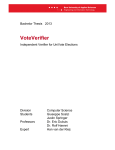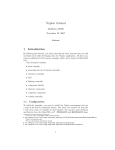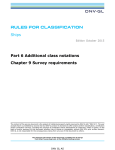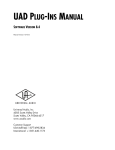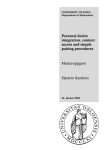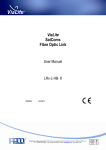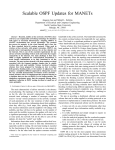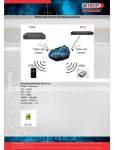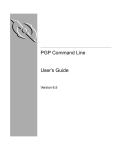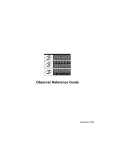Download User manual - Verificatum
Transcript
ERIFICATUM User Manual for the Verificatum Mix-Net Version 1.4.1 2015-05-11 The Verificatum mix-net is an implementation of a provably secure El Gamal-based mixnet. This document describes how to use the mix-net. For information about the design and implementation, please visit http://www.verificatum.org. Help us improve this document! The most recent version of this document can be found at http://www.verificatum.com. Report errors, omissions, and suggestions to [email protected]. Copyright 2008 2009 2010 2011 2012 2013 2014 2015 Verificatum AB Contents 1 Introduction 1 2 Info File Generator 1 3 Mix-Net 5 4 Object Generator 9 5 Demonstrator 11 6 Universally Verifiable Proof of Correctness 11 7 Converting Public Keys, Ciphertexts, and Plaintexts 13 8 Acknowledgments 14 A Byte Trees 15 B Representations of Arithmetic Objects 16 C Raw Format 19 D Alternative Formats 19 E Additional Command Line Tools 20 F Worked Example with Three Mix-Servers 21 G Usage Information for vmni 24 H Usage Information for vmn 28 I Usage Information for vog 31 J Usage Information for vmnv 33 K Usage Information for vmnc 35 L Usage Information for vre 36 1 Introduction The Verificatum mix-net (VMN) is an implementation of an El Gamal-based re-encryption mixnet. It can be configured in many ways, but all values have sensible defaults. The reader is expected to understand what an El Gamal-based mix-net is, but there is no need to understand the inner workings of the mix-net. Throughout the document we mark advanced sections by an asterix. These are sections that target programmers or power users that must use special configurations. These sections can safely be ignored in a first reading, or if these features are not needed. Components. All that is needed to execute the mix-net is to run a few commands in the right sequence. Thus, we hope that VMN is easy to use even for people who have limited knowledge of cryptography. The following are the basic commands. Command Description vmni Info file generator used to generate configuration files for the mix-net. Some optional configuration parameters are outputs from the object generator vog described below. Mix-server executing the VMN. The execution is parametrized by configuration files output from vmni. vmn vog vmnv vmnc Object generator of primitive cryptographic objects such as hash functions, keys, and pseudo-random generators. These can then, using vmni, be used to replace the default values. Verifier of universally verifiable non-interactive zero-knowledge proofs correct execution based on the Fiat-Shamir heuristic. Tool used to convert public keys, ciphertexts, and plaintexts to/from an application dependent format from/to the raw format used internally in VMN. Usage information. Usage information for each command can be printed by passing -h as an option to it. However, the usage information for the above commands are given as appendices Appendix G - Appendix K. Worked example. Appendix F contains a complete description of the commands executed by the respective operators in an execution with three mix-servers, including how to generate demo ciphertexts using the vmnd command described in Appendix E. 2 Info File Generator Before the mix-net is executed, the operators of the mix-servers must agree on a set of common parameters, generate their private and public parameters, and share their public parameters. 2.1 Basic Usage The info file generator is used in three steps. Below we walk through an example with three mixservers, where we describe the view of the operator of the first mix-server. The other operators execute corresponding commands. 1 1. Agree on common parameters. The operators agree on the name and session identifier of the execution and then generate a stub of a protocol file. To do that each operator invokes vmni as follows. vmni -prot -sid "SessionID" -name "Swedish Election" \ -nopart 3 -thres 2 stub.xml The command produces a protocol info stub file stub.xml. The parties can then verify that they hold identical protocol info stub files by computing digests as described below. The session identifier, which should be globally unique, can be used to separate multiple executions that logically should have the same name. In the example, the number of mixservers is 3 of which 2 are needed to decrypt ciphertexts encrypted with the joint public key produced during the key generation phase. 2. Generate individual info files. Using the protocol info stub file stub.xml as a starting point, each operator generates its own private info file and protocol info file by invoking vmni as in the following example. vmni -party -name "Mix-Server 1" stub.xml \ privInfo.xml localProtInfo.xml The command produces two files: a private info file privInfo.xml and an updated protocol info file localProtInfo.xml. The former contains private data, such as private signature keys. The latter defines the public parameters of a party, e.g., its IP address and public signature key. Each party must share its local protocol info file with the other mixservers using an authenticated channel. The protocol info stub file stub.xml can now be deleted. 3. Merge protocol info files. The operator now holds three protocol info files: its local file localProtInfo.xml, and the local files protInfo2.xml, and protInfo3.xml of the other parties. It merges these files using the following command. vmni -merge localProtInfo.xml protInfo2.xml protInfo3.xml \ protInfo.xml This produces a single joint protocol info file protInfo.xml containing all the common parameters and the public information about all parties. The output file does not depend on the order of the input protocol info files. The generated configuration files are write-protected to avoid accidental modifications. In practice, the operators could organize a physical meeting to which they bring their laptops and execute the above steps (in a way that is secure against side-channel attacks to not leak their secret keys). Alternatively, a simple protocol could be implemented using any PKI to perform the above tasks. Computing digests of info files. For convenience, hexadecimal encoded hash digests of files can be computed using vmni to allow all parties to check that they hold identical protocol info files at the end. In our example, a SHA-256 hexadecimal encoded digest of the joint protocol info file can be computed as follows. vmni -digest protInfo.xml 2 2.2 Execution in a Directory In a typical application, each operator creates a directory and executes the above commands in this directory. For convenience, the vmni command allows the operator to drop many info file name parameters when executing the commands in this way, in which case the file names default to the file names used above. A similar convention is later used for the vmn command described in Section 3. More precisely, the commands below are equivalent to the above. 1. Agree on common parameters. The following creates a stub info file stub.xml. vmni -prot -sid "SessionID" -name "Swedish Election" \ -nopart 3 -thres 2 2. Generate individual info files. The following assumes that there is a stub file named stub.xml in the working directory and then creates a private info file privInfo.xml and a protocol info file localProtInfo.xml. vmni -party -name "Mix-Server 1" 3. Merge protocol info files. The following creates a protocol info file protInfo.xml. vmni -merge localProtInfo.xml protInfo2.xml protInfo3.xml 2.3 Additional Configuration Options˚ The command vmni used to generate info files accepts a large number of options which allows defining various parameters of the mix-net. In our example we have simply used the default values, but we discuss a few of the important options below. For a complete usage description use the following command, or generate info files as above and inspect the resulting files. A comprehensive comment is generated for each value. vmni -h Pre-computation. The -maxciph option can be passed to vmni to invoke a pre-computation phase as explained in Section 3.2. For example, to configure the mix-net to process 10000 ciphertexts with pre-computation the option below can be used. (This is only used as a default and can be overridden for individual mixing sessions.) vmni -prot -sid "SessionID" -name "Swedish Election" \ -nopart 3 -thres 2 -maxciph 10000 stub.xml Changing the default key width. In some settings it is useful to have κ ą 1 public keys, in which case we say that the keywidth is κ. Let the set of plaintexts be Mκ “ Gκq , the set of ciphertexts be Cκ “ Mκ ˆ Mκ , and the space of randomness be Rκ “ Zκq . We can then define operations componentwise, i.e., if a, b P Mκ and e P Rκ , then ab “ pa1 b1 , . . . , aκ bκ q and ae “ pae11 , . . . , aeκκ q. We say that an element g P Mκ is a generator if the map f : Rκ Ñ Mκ defined by f peq “ g e is a bijection. 3 With these conventions in place, we may generalize El Gamal in the natural way. A generator g P Mκ is given. A secret key is x P Rκ is randomly chosen and the public key is then defined as pg, yq, where y “ g x . A plaintext m P Mκ is encrypted as pg r , y r mq. Decryption of a ciphertext pu, vq is simply defined as u´x v. Changing the default width of ciphertexts. A long plaintext that can not be embedded into a single group element can be split up and embedded into a list of group elements. A slight generalization (of the already generalized version) of El Gamal can then be used to encrypt the resulting list of group elements. More precisely, we let the set of plaintexts be Mκ,ω “ Mωκ , the set of ciphertexts be Cκ,ω “ Mκ,ω ˆ Mκ,ω , and the space of randomness be Rκ,ω “ Rωκ , and define encryption of a message m P Mκ,ω using ˘a public key pg, yq and randomness r P Rκ,ω ` by pu, vq “ pg r1 , . . . , g rw q, py r1 m1 , . . . , y rw mw q . By extending our notation we can even write this as pu, vq “ pg r , y r mq. We say that the width of plaintexts and ciphertexts is w. The mix-net can process a list of ciphertexts of any width, assuming of course that all ciphertexts have the same width. The -width option can be passed to the vmni command to change the default width for individual sessions. For example, the following changes the key width to 2 and the default width to 3. vmni -prot -sid "SessionID" -name "Swedish Election" \ -nopart 3 -thres 2 -keywidth 2 -width 3 stub.xml Secure source of randomness. The default source of randomness is the /dev/urandom device. This is often a reasonable choice, but on machines with few system events, this may not give sufficient entropy. The -rand option can be used to either use a different device, e.g., a hardware random generator mounted as a device, or a pseudo-random generator. In the latter case, the -seed option must also be used to provide the name of a file containing a relatively short truly random seed. Use the vog tool described in Section 4 to generate a hexadecimal-encoded instance of a random source that can be used as a value with -rand. Below we give two examples. vmni -party -name "Mix-Server 1" \ -rand "$(vog -gen RandomDevice /dev/urandom)" \ privInfo.xml localProtInfo.xml vmni -party -name "Mix-Server 1" \ -rand "$(vog -gen PRGElGamal -fixed 2048)" \ -seed /dev/urandom \ privInfo.xml localProtInfo.xml Note that multiple sources can be combined into a single source using the combiner class named com.verificatum.crypto.RandomSourceCombiner such that the security of the combined sources is as strong as the strongest of the combined source. Combining a hardware generator, /dev/urandom, and PRG should satisfy the requirements of any auditor. Using a different bulletin-board. The default bulletin board uses a stripped-down version of HTTP with mutual signatures, but it is easy to replace the default bulletin board by another bulletin board. The simplest way to replace the bulletin board is to merely use any existing HTTP server and use the -httptype external flag to vmni to indicate that an external HTTP server is serving 4 the files published as part of the existing bulletin board protocol. The rest of the protocol would then be intact. Alternatively a subclass of the abstract class com.verificatum.com.BullBoardBasic can be implemented. This class must contain the abstract methods: start, stop, publish, unpublish, and waitFor. These functions must behave as expected. They are used to start/stop the bulletin board and to publish or wait for something to be published by another party. Please consult the VMN source code for more details. Thus, it is easy to write a wrapper for an existing bulletin board implementation. If a bulletin board is implemented in a class FooBullBoard, then there must also exist a subclass of com.verificatum.com.BullBoardBasicGen named FooBullBoardGen that specifies the configuration data needed by the bulletin board. If a wrapper is implemented, then the configuration data can of course consist of a single field that specifies an external configuration file of the underlying bulletin board. Given a custom bulletin board FooBullBoard, the mix-net can be instructed to use it by the following command. vmni -party -name "Mix-Server 1" -bullboard FooBullBoard \ privInfo.xml localProtInfo.xml Note that if you use this option when printing usage info, then information about the configuration of your own bulletin board will be printed as well. Use the following to try this. vmni -h -bullboard FooBullBoard Running multiple mix-servers on a single computer. When the default bulletin board is used for communication between the mix-servers, each mix-server allocates two ports for communication: one for its HTTP server and one for its hint server. (The hint servers are used to optimistically reduce the need for servers to poll each other.) By default these port numbers are 8040 and 4040, and this typically works well when running a single mix-server. However, if there is a need to run several mix-servers on the same computer, e.g., when trying out VMN, then the mix-servers must be assigned distinct port numbers. The -http and -httpl options are used to define the external and local URL’s for the HTTP server. These can be distinct e.g., if port forwarding is used behind a NAT. If only -http is given, then the local port number defaults to the same value. If only -httpl is given, then the external port number remains 8040. Similarly, -hint, and -hintl options are used to define the socket address of the hint server. Below we give an example, but Appendix F also illustrates the use of these options. vmni -party -name "Mix-Server 1" \ -http http://server.example.com:8040 \ -hint server.example.com:4040 \ privInfo.xml localProtInfo.xml 3 Mix-Net When the info files of all mix-servers have been generated, the mix-net can be executed in two (or three) simple steps: generate a public key, optionally perform pre-computation, and process a 5 list of ciphertexts to produce a list of plaintexts. The formats used to represent the public key, the ciphertexts, and the plaintexts are detailed in Appendix C. Before we continue we warn the user. WARNING! On its own the mix-net provides no protection against Pfitzmann’s attack (malleability attack). Only use this software under the supervison of somebody that understand this warning. The reason why such protection is not provided is that it is inherently application dependent. The warning is meant to be a reminder and not an explanation. If you do not understand the warning or this remark, you need to ask a cryptographer for help before deploying the mix-net. 3.1 Basic Usage We complete the example from Section 2 by describing the sequence of commands executed by the operator to actually run the mix-net. We stress that each command invokes a protocol, so all operators must execute this command roughly at the same time. 1. Generate public key. The operators execute the joint key generation phase of the protocol which outputs a joint public key to a file publicKey to be used by senders when computing their ciphertexts. vmn -keygen privInfo.xml protInfo.xml publicKey 2. Mix ciphertexts. To start the mixing phase with a file ciphertexts containing ciphertexts to produce a file plaintexts containing plaintexts, the operator uses the following command. vmn -mix privInfo.xml protInfo.xml ciphertexts plaintexts If the info files were generated in a directory as explained in Section 2.2 and the above commands are executed in the same directory, then the names of the info files can be dropped here and below. Deleting a session. If there is a fatal error during the execution, or if an operator interrupts an execution by mistake, then all operators can execute the following command to delete all information about the current mixing session. vmn -delete privInfo.xml protInfo.xml Note that this only deletes the mixing data and not any information about the distributed key generation. Changing the set of active parties. For distributed bulletin boards, there is no practical way to determine if a party will deliver a message or if it simply delays messages, since the expected delays differ depending on the role of the mix-server, its hardware, its network connection, etc. Thus, the approach of VMN is to simply let each mix-server wait indefinitely for each message. If all mix-servers end up waiting for the same mix-server, then the operators may decide to interrupt 6 and delete the session and then deactivate the mix-server. If a mix-server is deactivated, then from the other mix-servers point of view it is as if it always publishes a fixed message whenever it is expected to publish a message. Thus, deactivated mix-servers emulate a particular type of corrupted mix-server and are handled as such in the subprotocols. The following two commands can be used to display and define the set of active parties. vmn -lact privInfo.xml protInfo.xml vmn -sact privInfo.xml protInfo.xml "{1,3}" The latter command sets the set of active servers to the first and third mix-servers. Both commands can be executed without explicitly giving the info files if previous commands were used in the same way. 3.2 Other Ways to Use the Mix-Net˚ The mix-net can be used to do more than simply mixing. Pre-computation can be used to speed up the shuffling phase of the mix-net, ciphertexts can be shuffled without decrypting, and ciphertexts can be decrypted without shuffling. A public key can be imported to the mix-net and used to shuffle ciphertexts without decrypting them. In combination with the session handling described in Section 3.3 and the ability to override the keywidth as described in Section 2.3 and the width as described in Section 3.4 this turns the mix-net into a blackbox that provides all the functionality needed in virtually all electronic voting systems. Pre-computation. Pre-computation can be used to speed up the mixing phase of the mix-net, but all mix-servers must agree on the number of ciphertexts for which pre-computation is performed. If the -maxciph option was used when generating the protocol info stub file, then there is a default number of ciphertexts for which pre-computation is performed and pre-computation followed by the mixing can be executed using the following commands. vmn -precomp privInfo.xml protInfo.xml vmn -mix privInfo.xml protInfo.xml ciphertexts plaintexts The default number of ciphertexts for which pre-computation is performed can be overridden by using the -maxciph option, and this is necessary if the default was not set to a positive value as outlined above. All mix-servers must of course use the same value. We stress that the the mix-servers execute a protocol during the pre-computation phase. Thus, all of the operators must execute this command roughly at the same time. Shuffling without decrypting. In some applications it is useful to shuffle the ciphertexts without decrypting. Use the following command to achieve this. vmn -shuffle privInfo.xml protInfo.xml \ ciphertexts ciphertextsout 7 Decrypting without shuffling. In other applications it is useful to simply decrypt ciphertexts. Strictly speaking this is not a mix-net functionality, but it is a natural functionality if we view the mix-net as a blackbox used to implement electronic voting systems. Use the following command to run the mix-net in this way. vmn -decrypt privInfo.xml protInfo.xml ciphertexts plaintexts Importing a public key. If protocols for key generation and decryption have already been implemented and the user prefers to use these, then the mix-net can still be used to shuffle ciphertexts without decrypting them. To use the mix-net in this way, the user simply sets the public key of the mix-net using the command below, instead of first running the key generation protocol. After this, the mix-net can of course only be used to shuffle ciphertexts as described above, but not to mix or decrypt ciphertexts. vmn -setpk privInfo.xml protInfo.xml publicKey 3.3 Multiple Sessions˚ In some applications it is useful to be able to run the key generation phase only once and then re-use the same public key for multiple executions of the mix-net. Each session is identified by an auxiliary session identifier, which must consist only of letters A-Z, a-z, and digits 0-9. Use the -auxsid option to specify a given auxiliary session identifier. For example, to simply mix a list of ciphertexts in a session with auxiliary session identifier abc123 you can use the following. vmn -mix -auxsid abc123 privInfo.xml protInfo.xml \ ciphertexts plaintexts To hide this functionality during basic usage, the auxiliary session identifier defaults to default, i.e., the following is equivalent to not specifying any auxiliary session identifier. vmn -mix -auxsid default privInfo.xml protInfo.xml \ ciphertexts plaintexts 3.4 Changing the width of ciphertexts.˚ The default width of ciphertexts in the protocol info file can be overridden by using the -width option. This may be useful if the width is not known when the keys are generated or if different widths are used in different sessions. For example, to change the width to 3 in the execution of the mix-net, use the following command. vmn -mix -width 3 privInfo.xml protInfo.xml \ ciphertexts plaintexts Similarly, to override the default width during pre-computation, use the following command. vmn -precomp -width 3 privInfo.xml protInfo.xml 8 Note that all mix-servers must use the same width. 3.5 Rearranging public keys and ciphertexts.˚ Consider a set of ciphertexts of a given width. It may be useful, e.g., to only decrypt the first component of each ciphertext. The mix-net already supports decrypting ciphertexts of different widths, but a tool is needed to extract the first component. The command vre provides this functionality and much more. It allows combining components of ciphertexts from multiple lists of ciphertexts. The command can also extract subsets of a list of ciphertexts or concatenate lists of ciphertexts. Furthermore, public keys keys may have different key widths. The command can extract components of public keys and combine these components into new public keys. The command provides the corresponding functionality for ciphertexts encrypted using the original public keys. This command can, e.g., be used to: (1) let two distinct sets of mix-servers run two mix-nets that generate two public keys, (2) combine them into a new single public key, (3) encrypt messages using the combined public key, (4) shuffle the combined ciphertexts, (5) extract the components of each ciphertext encrypted using the first public key, and (6) decrypt the extracted components. This is only one example, the command vre is very powerful and the best way to understand the functionality is reading the usage information and try it out. The usage information is found in Appendix 3.5 4 Object Generator Some of the option parameters passed to vmni can be complex objects, i.e., a provably secure pseudo-random generator may be based on a computational assumption that must be part of the encoding. The object generator vog is used to generate representations of such objects. Before any objects are generated, the source of randomness of the object generator must be initialized, but we postpone the discussion of this to Section 4.2. 4.1 Listing and Generating Objects The main usage of vog is to list all suitable subclasses of some class specified as a valid parameter to vmni, and then to generate an instance of such a class. Browse Library. Consider an option to vmni that is parametrized by instance of a subclass of a class AbstractClass. Then the set of subclasses of AbstractClass that can be instantiated using vog can be listed using the following command. vog -list AbstractClass For example, the source of randomness used by a protocol can be chosen by passing an instance of a subclass of com.verificatum.crypto.RandomSource to vmni using the -rand option. (Use vmni -h to find out which type of object can be passed as a parameter with each option.) To list all suitable subclasses, the following command can be used. vog -list RandomSource As illustrated by the example it suffices to give the unqualified class name when this is not ambiguous. 9 Generate Object. To generate an instance of ConcreteClass the -gen option is used along with the name of the class, but each class requires its own set of parameters. To determine the correct set of parameters the following command can be used. vog -gen ConcreteClass -h This prints usage information as if vog -gen ConcreteClass was a command on its own. An instance is then generated by passing the correct parameters, e.g., to generate an instance of HashfunctionHeuristic that represents SHA-512, the following command can be used. vog -gen HashfunctionHeuristic SHA-512 For some classes, the parameters passed to vog must in turn be generated using vog itself, e.g., PRGHeuristic optionally takes the representation of a hash function as input as illustrated in the following. vog -gen PRGHeuristic \ "$(vog -gen HashfunctionHeuristic SHA-256)" This approach of constructing parametrized complex objects is quite powerful. We can for example construct an instance of PRGCombiner that combines a random device and two pseudorandom generators using the following command. vog -gen PRGCombiner "$(vog -gen RandomDevice /dev/urandom)" "$(vog -gen PRGElGamal -fixed 1024)" "$(vog -gen PRGHeuristic "$(vog -gen HashfunctionHeuristic SHA-256)" )" 4.2 \ \ \ \ \ Initializing the Random Source Before vog is used to generate any objects, its source of randomness must be initialized. This is only done once. The syntax is almost identical to the syntax to generate an instance of a subclass of RandomSource, except that it is mandatory to provide a seed if a pseudo-random generator is used. We give two examples. The first example initializes the random source to be the random device /dev/urandom. Any device can of course be used, e.g., a hardware random generator mounted as a device. To avoid accidental reuse of randomness, this option should never be used with a normal file. vog -rndinit RandomDevice /dev/urandom The second example shows how to initialize the random source as a pseudo-random generator where the seed is read directly from /dev/urandom. vog -seed /dev/urandom -rndinit \ PRGHeuristic "$(vog -gen HashfunctionHeuristic SHA-256)" 10 A representation of the random source is stored in the file .verificatum random source in the home directory of the user. If the environment variable VERIFICATUM RANDOM SOURCE is defined, then it is taken to be the name of a file to be used instead. If the random source is a pseudo-random generator, i.e., a subclass of com.verificatum.crypto.PRG, then the hexadecimal encoding of its seed is stored in the file .verificatum random seed, or if the environment variable VERIFICATUM RANDOM SEED is defined it is interpreted as a file name to be used instead. Note that the seed is automatically replaced with part of the output of the pseudo-random generator in each invocation to avoid accidental reuse of the seed. 4.3 Custom Objects˚ To allow vog to instantiate a custom subclass CustomClass, e.g., of PGroup, a separate subclass CustomClassGen of com.verificatum.ui.gen.Generator must also be implemented. Please note the naming convention where Gen is added as a suffix to the class name. The generator class provides the command-line interface to CustomClass, i.e., it prints usage information, and interprets command-line parameters and returns an instance of CustomClass. See the source for HashfunctionHeuristicGen for a simple example. There are two ways to make vog aware of such custom classes: (1) a colon-separated list of classes can be provided as a parameter with the -pkgs option, or (2) the environment variable VERIFICATUM VOG can be initialized to such a list. Each class identifies a package to be considered by vog, so it suffices to provide a single class from each package to be considered. 5 Demonstrator The demo directory of the VMN package contains a number of demo scripts. The following simple command runs the demo with the default options. ./demo The demo can be configured to illustrate many options of the mix-net. It is also easy to configure it to remotely orchestrate an execution on other servers. For more information we refer the reader to the README file and the configuration file conf found in the demo directory. Concrete Example. Appendix F also contains a simple worked example of the commands executed by the operators including how to generate demo ciphertexts using the vmnd command. 6 Universally Verifiable Proof of Correctness By default, vmni generates a protocol info stub file such that all zero-knowledge proofs computed during the execution of vmn are made non-interactive using the Fiat-Shamir heuristic. When vmn is executed in this mode it stores all the relevant intermediate results along with the non-interactive zero-knowledge proofs in a subdirectory of the nizkp subdirectory of the working directory of vmn. The subdirectory is named using the auxiliary session identifier of the mixing/shuffling/decryption session, by default this it is named default (since this is the default auxiliary session identifier). The contents of this directory can then be verified by anybody who has the necessary knowledge to implement a verification algorithm. Thus, VMN is said to be universally verifiable. 11 6.1 Verificatum Mix-Net Verifier Let protInfo.xml be a protocol info file and let default be a directory containing an intermediate values and non-interactive zero-knowledge proof. Then the following commands can be used to verify the correctness of proofs of mixing/shuffling/decryption. The command vmnv is completely silent by default and halt with exit status 0 upon success, and otherwise halt with a non-zero exit status. The -v option can be used to turn on verbose output displaying progress and the verifications performed. Syntax errors or incorrect usage gives error messages even if the -v option is not used. Proof of Mixing. The validity of a proof of a mixing can be verified using the following command. vmnv -mix protInfo.xml default This command gives a usage error if the proof is not even a proof of a mixing. The -nopos option turns off verification of proofs of shuffles. The -nodec option turns off verification of the proof of decryption. This allows verifying a part of a proof. If pre-computation was used during the execution of the mix-net, then the -noposc option can be used to turn off verification of proofs of shuffles of commitments, and the -ccpos option can be used to turn off verification of the commitment-consistent proofs of shuffles. These options gives a usage error if pre-computation was not used during the execution producing the proof. It is quite natural to use -noccpos and -nodecr to verify that the pre-computation phase was performed correctly, but nothing else, and then later using -noposc to verify the commitmentconsistent proofs of shuffles and the decryption, but not the proofs of shuffles of commitments. Proof of Shuffling. If the mix-net only shuffled the ciphertexts without decrypting, then the proofs of shuffles can be verified using the following command. vmnv -shuffle protInfo.xml default If pre-computation was used, then the options -noposc and -noccpos can be used as above. These options gives a usage error if the proof is not the result of an execution with pre-computation. Proof of Decryption. If the mix-net was only used to decrypt a list of ciphertexts, then the corresponding proof can be verified using the following command. vmnv -decrypt protInfo.xml default Sloppy Verification. It is also possible to verify the correctness of a proof of a mixing/shuffling/decryption without stating which (or the auxiliary session identifier or actual width as described below). This option should not be used in real applications, since it is dangerous to not explicitly state the expected type of proof. vmnv -sloppy protInfo.xml default 12 Non-default Parameters. For a given mixing/shuffling/decryption session both the auxiliary session identifier that specifies the session, as well as the width of ciphertexts can be changed. To verify a proof of such a session these values must be given explicitly to the verifier. S PECIFYING THE AUXILIARY S ESSION I DENTIFIER . The auxiliary session identifier is default by default in the above calls (it is not derived from the file name). To use a given session identifier abc123 use the following command instead (and similarly for verifying only shuffling or only decryption). vmnv -mix -auxsid abc123 protInfo.xml abc123 C HANGING THE WIDTH OF CIPHERTEXTS . If the default width of ciphertexts specified in the protocol info file was overridden when executing the mix-net, then the width must be passed to the verifier as well. For example, use the following to verify the default session with a non-default width equal to 3. vmnv -mix -width 3 protInfo.xml default 6.2 Completing a Verification Using the Verificatum Verifier The formats of the public key file handed to senders, the file containing the input ciphertexts, and the output file containing decoded plaintexts (or output file containing ciphertexts) may be different from VMN’s internal format used to represent the corresponding objects as files in the proof directory. Thus, to verify the overall correctness of an execution in an application, it must be ensured that the representations are consistent. There is obviously no general way to do this, since the formats used are inherently application dependent. However, one possibility is to use the vmnc as explained in Section 7 to convert the objects and then simply use diff to compare the output with the expected result in the proof directory. 6.3 Independent Stand-alone Mix-Net Verifiers˚ Universal verifiability is of course more interesting if independent parties implement stand-alone verifiers. These verifiers should preferably share no code with VMN itself. We suggest that the reader takes a moment to consider the depth of this requirement. In a companion document [2] targeting programmers of such verifiers, the formats of the files in a proof directory and the algorithms that must be implemented are described in detail. Independent verifiers must of course implement a conversion tool for completing the verification independently as explained in Section 6.2. 7 Converting Public Keys, Ciphertexts, and Plaintexts The public key resulting from the key generation phase, the input ciphertexts, and the output plaintexts (or output ciphertexts), are represented using the internal format of VMN. This format is detailed in Appendix C. In practice, the public key and the input ciphertexts may be represented in different ways in different applications, and the output plaintexts (our outputs) are typically decoded into strings somehow. VMN comes with the tool vmnc that can be used to perform the needed conversion 13 or decoding to/from these formats. A custom format can be used1 by implementing a subclass of com.verificatum.protocol.ProtocolElGamalInterface, but there are also a few pre-defined formats described in Appendix D. The mix-net outputs a public key or accepts an externally generated public key as input, it accepts ciphertexts as input and may also output ciphertexts, but it only outputs plaintexts. Thus, it is possible to specify the input and output formats when converting public keys and ciphertexts, but only the output format when decoding plaintexts. The default value of each interface is raw, which is the internal format of VMN. For example, use the following commands to: (1) convert a public key output by the mix-net to native format, (2) convert input ciphertexts in native format to ciphertexts in raw format for the mix-net, and (3) decode plaintext group elements from the mix-net in raw format to plaintexts in native format. vmnc -pkey -outi native protInfo.xml publicKey publicKeyNative vmnc -ciphs -ini native protInfo.xml \ ciphertextsNative ciphertexts vmnc -plain -outi native protInfo.xml \ plaintexts plaintextsNative 8 Acknowledgments The suggestions of Torbjörn Granlund, Shahram Khazaei, and Gunnar Kreitz have improved this document. References [1] Digital signature standard (DSS). Digital signature standard (DSS). National Institute of Standards and Technology, Washington, 2000. URL: http://csrc.nist.gov/publications/fips/. Note: Federal Information Processing Standard 186-2. [2] D. Wikström. How to implement a stand-alone verifier for the Verificatum mix-net. http: //www.verificatum.org, October 2011. 1 If you want to try out your own format in the demo, you can instead implement your own subclass of com.verificatum.protocol.ProtocolElGamalInterfaceDemo. This merely adds functionality for generating demo ciphertexts using your format. 14 A Byte Trees We use a byte-oriented format to represent objects on file and to turn them into arrays of bytes. The goal of this format is to be as simple as possible. A.1 Definition A byte tree is either a leaf containing an array of bytes, or a node containing other byte trees. We write leaf(d) for a leaf with a byte array d and we write node(b1 , . . . , bl ) for a node with children b1 , . . . , bl . Complex byte trees are then easy to describe. Example 1. The byte tree containing the data AF, 03E1, and 2D52 (written in hexadecimal) in three leaves, where the first two leaves are siblings, but the third is not, is nodepnodepleafpAFq, leafp03E1qq, leafp2D52qq . A.2 Representation as an Array of Bytes We use bytesk pnq as a short-hand to denote the 8k-bit two’s-complement representation of n in big endian byte order, where n is given in decimal notation. We also use hexadecimal notation for constants, e.g., 0A means bytes1 p10q. A byte tree is represented by an array of bytes as follows. • A leaf leafpdq is represented by the concatenation of: a single byte 01 to indicate that it is a leaf, four bytes bytes4 plq, where l is the number of bytes in d, and the data bytes d. • A node nodepb1 , . . . , bl q is represented by the concatenation of: a single byte 00 to indicate that it is a node, four bytes bytes4 plq representing the number of children l, and bytespb1 q | bytespb2 q | ¨ ¨ ¨ | bytespbl q, where | denotes concatenation and bytespbi q denotes the representation of the byte tree bi as an array of bytes. Example 2 (Example 1 contd.). The byte tree is represented as the following array of bytes. 00 00 00 00 02 00 00 00 00 02 01 00 00 00 01 AF 01 00 00 00 02 03 E1 01 00 00 00 02 2D 52 A.3 ASCII Strings ASCII strings are identified with the corresponding byte arrays. No ending symbol is used to indicate the length of the string, since the length of the string is stored in the leaf. Example 3. The string "ABCD" is represented by leafp65666768q. A.4 Hexadecimal Encodings Sometimes we store byte trees as the hexadecimal encoding of their representation as an array of bytes. We denote by hexpaq the hexadecimal encoding of an array of bytes a. We denote by unhexpsq the reverse operation that converts an ASCII string s of an even number of digits 0-9 and A-F into the corresponding array of bytes. 15 B Representations of Arithmetic Objects Every arithmetic object in VMN is represented as a byte tree. In this section we pin down the details of these representations. We describe how to represent elements in product rings and product groups, as well as arrays of such elements. These products are basically lists of elements and operations are applied element wise. B.1 Basic Objects Integers. A multi-precision integer n is represented by leafpbytesk pnqq for the smallest possible integer k. Example 4. 263 is represented by 01 00 00 00 02 01 07. Example 5. ´263 is represented by 01 00 00 00 02 FE F9. Arrays of booleans. An array pa1 , . . . , al q of booleans is represented as leafpbq, where b is an array pb1 , . . . , bl q of bytes where bi equals 01 if ai is true and 00 otherwise. Example 6. The array ptrue, false, trueq is represented by leafp01 00 01q. Example 7. The array ptrue, true, falseq is represented by leafp01 01 00q. B.2 Prime Order Fields Field element. An element a in a prime order field Zq is represented by leafpbytesk paqq, where a is identified with its integer representative in r0, q ´ 1s and k is the smallest possible k such that q can be represented as bytesk pqq. In other words, field elements are represented using fixed size byte trees, where the fixed size only depends on the order of the field. Example 8. 258 P Z263 is represented by 01 00 00 00 02 01 02. Example 9. 5 P Z263 is represented by 01 00 00 00 02 00 05. Array of field elements. An array pa1 , . . . , al q of field elements is represented by a byte tree nodepa1 , . . . , al q, where ai is the byte tree representation of ai . Example 10. The array p1, 2, 3q of elements in Z263 is represented by: 00 00 00 00 03 01 00 00 00 02 00 01 01 00 00 00 02 00 02 01 00 00 00 02 00 03 B.3 Product Rings Product ring element. An element a “ pa1 , . . . , ak q in a product ring is represented by a byte tree nodepa1 , . . . , ak q, where ai is the byte tree representation of the component ai . Note that this representation keeps information about the order in which a product group is formed intact (see the second example below). Example 11. The element p258, 5q P Z263 ˆ Z263 is represented by: 00 00 00 00 02 01 00 00 00 02 01 02 01 00 00 00 02 00 05 16 Example 12. The element pp258, 6q, 5q P pZ263 ˆ Z263 q ˆ Z263 is represented by: 00 00 00 00 02 00 00 00 00 02 01 00 00 00 02 01 02 01 00 00 00 02 00 06 01 00 00 00 02 00 05 Array of product ring elements. An array pa1 , . . . , al q of elements in a product ring where ai “ pai,1 , . . . , ai,k q, is represented by nodepb1 , . . . , bk q, where bi is the array pa1,i , . . . , al,i q and bi is its representation as a byte tree. Thus, the structure of the representation of an array of ring elements mirrors the representation of a single ring element. This seemingly contrived representation turns out to be convenient in implementations. ` ˘ Example 13. The array p1, 4q, p2, 5q, p3, 6q of elements in Z263 ˆ Z263 is represented as 00 00 00 00 02 00 00 00 00 03 01 00 00 00 02 00 01 01 00 00 00 02 00 02 01 00 00 00 02 00 03 00 00 00 00 03 01 00 00 00 02 00 04 01 00 00 00 02 00 05 01 00 00 00 02 00 06 B.4 Multiplicative Groups Modulo Primes Group. A subgroup Gq of prime order q of the multiplicative group Z˚p , where p ą 3 is prime, with standard generator g is represented by the byte tree nodepp, q, g, bytes4 peqq , where the integer e encoded as four bytes determines how a string is encoded into a group element and can be ignored for the purpose of this document. We stress that g is the byte tree representation of g viewed as a group element as defined below. Group element. An element a P Gq , where Gq is a subgroup of prime order q of Z˚p for a prime p is represented by leafpbytesk paqq, where a is identified with its integer representative in r0, p ´ 1s and k is the smallest integer such that p can be represented as bytesk ppq. Example 14. Let Gq be the subgroup of order q “ 131 in Z˚263 . Then 258 P Gq is represented by 01 00 00 00 02 01 02. Example 15. Let Gq be the subgroup of order q “ 131 in Z˚263 . Then 3 P Gq is represented by 01 00 00 00 02 00 03. 17 B.5 Standard Elliptic Curves over Prime Order Fields Group. A standard elliptic curve group named FooCurve is represented by the byte tree leafp"FooCurve"q. Example 16. The group P-256 from FIPS 186-3 [1] is represented by leafp"P-256"q. The following curves are currently implemented by VMN, each defining the order of the underlying field, the curve equation, the order of the group, and the standard generator. P-192 P-224 P-256 P-384 P-521 brainpoolp192r1 brainpoolp224r1 brainpoolp256r1 brainpoolp320r1 brainpoolp384r1 brainpoolp512r1 prime192v1 prime192v2 prime192v3 prime239v1 prime239v2 prime239v3 prime256v1 secp192k1 secp192r1 secp224k1 secp224r1 secp256k1 secp256r1 secp384r1 secp521r1 Group element. Let the curve be defined over a prime order field Zp and let k be the smallest integer such that p can be represented as bytesk ppq. Then an affine point P “ px, yq on the curve is represented by nodepleafpbytesk pxqq, leafpbytesk pyqqq and the point at infinity is represented by nodepleafpbytesk p´1qq, leafpbytesk p´1qqq. Note that a fixed-size representation of ´1 is used. B.6 Arrays of Group Elements and Product Groups Array of group elements. An array pa1 , . . . , al q of group elements is represented by a byte tree nodepa1 , . . . , al q, where ai is the byte tree representation of ai . Product group element. An element a “ pa1 , . . . , ak q in a product group is represented by nodepa1 , . . . , ak q, where ai is the byte tree representation of ai . Array of product group elements. An array pa1 , . . . , al q of elements in a product group, where ai “ pai,1 , . . . , ai,k q, is represented by nodepb1 , . . . , bk q, where bi is the array pa1,i , . . . , al,i q and bi is its representation as a byte tree. B.7 Marshalling Groups When objects are converted to byte trees in VMN, they do not store the name of the Java class of which they are instances. Thus, to recover an object from such a representation additional information must be available. Java serialization would not be language independent. Furthermore, only a few objects must be converted, so we use a simplified scheme where a group Gq represented by an instance of a Java class PGroupClass in VMN is marshalled into a byte tree nodepleafp"PGroupClass"q, Gq q . This byte tree in turn is converted into a byte array which is coded into hexadecimal and prepended with an ASCII comment. The comment and the hexadecimal coding of the byte array are separated by double colons. The resulting ASCII string is denoted by s “ marshalpGq q and the group Gq recovered from s by removing the comment and colons, converting the hexadecimal string to a byte array, converting the byte array into a byte tree, and converting the byte tree into a group Gq , is denoted by Gq “ unmarshalpsq. 18 Groups in VMN. Currently, there are two implementations of groups in VMN: Implementation Description com.verificatum.arithm.ModPGroup Multiplicative groups. com.verificatum.arithm.ECqPGroup Standard elliptic curve groups over prime order fields. Example 17. The standard NIST curve P-256 [1] is marshalled into nodepleafp"com.verificatum.arithm.ECqPGroup"q, leafp"P-256"qq . C Raw Format The internal representation of groups and group elements is used to represent the public key (with an embedded representation of the underlying group), the input ciphertexts, and output plaintext group elements. These objects depend on the underlying group Gq of order q, the key width κ, and the ciphertext width ω. Let M “ Gq be the underlying group, let Mκ “ Mκ be the plaintext group, let Cκ “ Mκ ˆ Mκ be the public key group, and let Cκ,ω “ Mωκ ˆ Mωκ be the ciphertext group. The public key file contains nodepmarshalpMκ q, pk q, where pk P Cκ is the public key in the product group. Note that the public key does not depend on the width of the ciphertexts. The array L0 of input ciphertexts in Cκ,ω is represented on file as L0 and the array m of output plaintext group elements in Mκ,ω is represented on file as m. We stress that the output group elements are not decoded into strings. The vbt command can be used to display the contents of a byte tree in a structured way. D Alternative Formats The vmnc tool can be used to convert public keys and ciphertexts to and from an application dependent format as well as decoding plaintext group elements in an application dependent way. There are a few built-in format, but it is also easy to implement a custom format and use it with vmnc. D.1 Native Format The native format converts the binary objects of the raw format to their hexadecimal representation as ASCII strings and does not require the number of ciphertexts in the input file to be available at the start of parsing the file. It also decodes the output plaintext group elements into strings according to the encoding scheme of the underlying group. More precisely, hexpnodepmarshalpMκ q, pk qq is output on the public key file, where pk denotes the public key in Cκ . For each line in the file of input ciphertexts an attempt is made to interpret it as hexpwq for some ciphertext w P Cκ,ω . Lines for which this fails are ignored. The array m of plaintext group elements in Mκ,ω is decoded element-wise into strings using the decoding scheme of the underlying group. Any occurrence of a newline or carriage return character in a string is deleted before the strings are output on file separated by newline characters. 19 D.2 JSON Format The JSON format assumes that a subgroup of a multiplicative group modulo a prime is used and that κ “ ω “ 1. i.e., that the underlying group is represented in VMN as an instance of com.verificatum.arithm.ModPGroup and that each plaintext is a single group element. The format of the public key file is best explained by an example. Suppose that p “ 23, q “ 11, and that Gq is the subgroup of order q in Z˚p . Let pg, yq “ p3, 13q be a public key in Gq ˆ Gq . Then the public key is represented as {"g":"3","p":"23","q":"11","y":"13"} . Similarly, a ciphertext p12, 16q P Gq ˆ Gq is represented as {"alpha":"12","beta":"16"} and the input file of ciphertexts contains a single such line for each ciphertext without any additional delimiters. The output file of plaintexts is constructed exactly like in the native format. D.3 Custom Format The custom format of the mix-net is captured by a subclass of ProtocolElGamalInterface, found in the com.verificatum.protocol package. This class requires every subclass to implement the following methods. Method Description writePublicKey writeCiphertexts Writes a public key to file, including the underlying group in marshalled form. Reads a public key from file, including the underlying group in marshalled form. Writes ciphertexts to file. readCiphertexts Reads ciphertexts from file. decodePlaintexts Decodes plaintext group elements and writes the result to file. standardRandomSource Creates a source of randomness, which is needed to be able to check the correctness of some inputs probabilistically. readPublicKey Please consider the source of, e.g., ProtocolElGamalInterfaceNative (in the same package), for an example of a subclass. E Additional Command Line Tools VMN comes with a number of additional tools used for debugging the mix-net itself or a standalone verifier. Use each command with the -h flag for more information. 20 Command Description vmnd Generates plaintext group elements. vbt Command used to print a byte tree on file as a recursive JSON array with data printed as hexadecimal strings. vhttp Command used to run the built-in HTTP server as a stand-alone server. This is mostly used to test the ability of the mix-net to use an external mix-server as its basis of a bulletin board. Command used to unit test basic classes. vtest vdemo Command used to run demos for subprotocols, where accompanying demo class exists. This is used for debugging subprotocols. vspt Lists safe primes in a given interval of integers. F Worked Example with Three Mix-Servers ###################### Set up directories ############################ mkdir -p mydemo/01 mkdir -p mydemo/02 mkdir -p mydemo/03 ##################### Executed by Operator 1 ######################### #### Step 0 #### Generate stub file. cd mydemo/01 vmni -prot -sid "SessionID" -name "Swedish Election" \ -nopart 3 -thres 2 #### Step 1 #### Generate private info and protocol info files. vmni -party -name "Mix-server 01" \ -http http://localhost:8041 \ -hint localhost:4041 # Copy protocol info files using out-of-bound channel. cp localProtInfo.xml protInfo01.xml cp protInfo01.xml ../02/ cp protInfo01.xml ../03/ #### Step 2 #### Merge protocol files and generate public key. vmni -merge protInfo??.xml vmn -keygen publicKey #### Step 3 #### Generate demo ciphertexts (in reality by senders). vmnd -ciphs publicKey 100 ciphertexts cp ciphertexts ../02/ cp ciphertexts ../03/ #### Step 4 #### Mix the ciphertexts. 21 vmn -mix ciphertexts plaintexts ##################### Executed by Operator 2 ######################### #### Step 0 #### Generate stub file. cd mydemo/02 vmni -prot -sid "SessionID" -name "Swedish Election" \ -nopart 3 -thres 2 #### Step 1 #### Generate private info and protocol info files. vmni -party -name "Mix-server 02" \ -http http://localhost:8042 \ -hint localhost:4042 # Copy protocol info files using out-of-bound channel. cp localProtInfo.xml protInfo02.xml cp protInfo02.xml ../01/ cp protInfo02.xml ../03/ #### Step 2 #### Merge protocol files and generate public key. vmni -merge protInfo??.xml vmn -keygen publicKey #### Step 3 #### Wait for demo ciphertexts (generated by Operator 1). #### Step 4 #### Mix the ciphertexts. vmn -mix ciphertexts plaintexts ##################### Executed by Operator 3 ######################### #### Step 0 #### Generate stub file. cd mydemo/03 vmni -prot -sid "SessionID" -name "Swedish Election" \ -nopart 3 -thres 2 #### Step 1 #### Generate private info and protocol info files. vmni -party -name "Mix-server 03" \ -http http://localhost:8043 \ -hint localhost:4043 # Copy protocol info files using out-of-bound channel. cp localProtInfo.xml protInfo03.xml cp protInfo03.xml ../01/ cp protInfo03.xml ../02/ #### Step 2 #### Merge protocol files and generate public key. vmni -merge protInfo??.xml vmn -keygen publicKey #### Step 3 #### Wait for demo ciphertexts (generated by Operator 1). #### Step 4 #### Mix the ciphertexts. 22 vmn -mix ciphertexts plaintexts ################## Verify Zero-Knowledge Proof ####################### # Verify internal consistency of Fiat-Shamir proof and correspondence # with public key, input ciphertexts, and ouput plaintexts. vmnv -mix protInfo.xml dir/nizkp/default 23 G Usage Information for vmni Usage: vmni -h [-bullboard <value>] vmni -prot -sid <value> -name <value> -nopart <value> -thres <value> [-bullboard <value>] [-cerr] [-corr <value>] [-descr <value>] [-e] [-ebitlen <value>] [-ebitlenro <value>] [-keywidth <value>] [-maxciph <value>] [-pgroup <value>] [-prg <value>] [-rohash <value>] [-statdist <value>] [-vbitlen <value>] [-vbitlenro <value>] [-width <value>] <protInfoOut> vmni -party -name <value> [-arrays <value>] [-cerr] [-cert <value>] [-descr <value>] [-dir <value>] [-e] [-hint <value>] [-hintl <value>] [-http <value>] [-httpdir <value>] [-httpl <value>] [-httptype <value>] [-keygen <value>] [-nizkp <value>] [-pkey <value>] [-rand <value>] [-seed <value>] [-skey <value>] [-srtbyrole <value>] <protInfoIn> <privInfo> <protInfoOut> vmni -merge [-cerr] [-e] <protInfoIn> ... <protInfoOut> vmni -digest [-hash <value>] <file> vmni -schema <type> vmni -version Description: This command is used to generate the configuration file of a protocol in three simple steps: (1) Each party generates a stub protocol info file with the global parameters. (2) Each party generates private and protocol info files. (3) Each party merges all protocol info files into a single protocol info file. The options "-prot", "-party", and "-merge" must appear as the first option. Use "-prot" to generate the global stub file containing only the global parameters that all parties agree on. For example: vmni -prot -sid "SID" -name "Execution" -nopart 3 -thres 2 stub.xml Use "-party" to generate: (i) a private info file containing your private parameters, e.g., your secret signing key, and (ii) a new protocol info file based on the input protocol info stub file, where all your public information has been added. For example: vmni -party -name "Santa Claus" stub.xml privInfo1.xml protInfo1.xml (If you use a PRG as the "-rand" (random source), then use the "-seed" option as well and specify a seed file (or device) containing a seed of suitable length.) Use "-merge" to generate a single protocol info file from several protocol info files with identical joint parameters. Assuming that the ith party names its info files as above: 24 vmni -merge protInfo1.xml protInfo2.xml protInfo3.xml protInfo.xml All optional values have reasonable defaults, i.e., you can actually use the above commands provided that /dev/urandom contains good randomness. Please generate dummy files to investigate exactly what these defaults are. It is unwise to touch the defaults unless you know exactly what you are doing. The stub filename can be dropped when the "-prot" option is used, in which case it defaults to "stub.xml". Similarly, the filenames can be dropped when using the "-party" option, in which case they default to "stub.xml", "privInfo.xml", and "localProtInfo.xml". The name of the output joint protocol info file can also be dropped when using the "-merge" option, in which case it defaults to "protInfo.xml" Parameters: <file> <privInfo> <protInfoIn> <protInfoOut> Options: -arrays <value> -bullboard <value> -cerr -cert <value> -corr <value> -descr <value> -digest -dir <value> -e -ebitlen <value> -ebitlenro <value> -h -hash <value> -hint <value> -hintl <value> -http <value> -httpdir <value> - Info file. - Private info output file. - Protocol info file containing joint parameters and possibly some party info entries. - Protocol info output file. - Determines if arrays of group/field elements and integers are stored in (possibly virtual) RAM or on file. The latter is only slighly slower and can accomodate larger arrays ("ram" or "file"). - Name of bulletin board implementation used, i.e., a subclass of com.verificatum.protocol.com.BullBoardBasic. - Print error messages as clean strings without any error prefix or newlines. - Certainty with which probabilistically checked parameters are verified, i.e., the probability of an error is bounded by 2ˆ(-cert). - Determines if the proofs of correctness of an execution are interactive or non-interactive. Legal valus are "interactive" or "noninteractive". - Description of this protocol execution. This is merely a longer description than the name of the protocol execution. - Compute hexadecimal encoded digest of file. - Working directory of this protocol instance. - Print exception trace upon error. - Bit length of each component in random vectors used for batching. - Bit length of each component in random vectors used for batching in non-interactive random-oracle proofs. - Display usage information - Name of an algorithm from the SHA-2 family, i.e., SHA256, SHA-384, or SHA-512. (Default is SHA-256.), used to compute a digest of an info file. - Socket address given as <hostname>:<port> or <ip address>: <port> to our hint server. A hint server is a simple UDP server that reduces latency and traffic on the HTTP servers. - Socket address given as <hostname>:<port> or <ip address>: <port>, where our hint server listens for connections, which may be different from the address used to access it, e.g., if it is behind a NAT. - URL to the HTTP server of this party. - Root directory of HTTP server. 25 -httpl <value> -httptype <value> -keygen <value> -keywidth <value> -maxciph <value> -merge -name <value> -nizkp <value> -nopart <value> -party -pgroup <value> -pkey <value> -prg <value> -prot -rand <value> -rohash <value> -schema <type> -seed <value> -sid <value> -skey <value> -srtbyrole <value> -statdist <value> - URL where the HTTP-server of this party listens for connections, which may be different from the HTTP address used to access it, e.g., if it is behind a NAT. - Decides if an internal or external HTTP server is used. Legal values are "internal" or "external". - Determines the key generation algorithm used to generate keys for the CCA2-secure cryptosystem with labels used in subprotocols. An instance of com.verificatum.crypto. CryptoKeyGen. - Width of El Gamal keys. If equal to one the standard El Gamal cryptosystem is used, but if it is greater than one, then the natural generalization over a product group of the given width is used. This corresponds to letting each party holding multiple standard public keys. - Maximal number of ciphertexts for which precomputation is performed. Pre-computation can still be forced for a different number of ciphertexts for a given session using the "-maxciph" option during pre-computation. - Merge several protocol info files with identical joint parameters into a single protocol info file. - Name of this protocol execution. This is a short descriptive name that is NOT necessarily unique. - Destination directory for non-interactive proof. Paths are relative to the working directory or absolute. - Number of parties taking part in the protocol execution. - Generate private and protocol info files based on the given protocol info stub file. - Group over which the protocol is executed. An instance of a subclass of com.verificatum.arithm.PGroup. - Public signature key (instance of subclasses of com. verificatum.crypto.SignaturePKey). - Pseudo random generator used to derive random vectors for batchingfrom jointly generated seeds. This can be "SHA256", "SHA-384", or "SHA-512", in which case com. verificatum.crypto.PRGHeuristic is instantiated based on this hashfunction, or it can be an instance of com. verificatum.crypto.PRG. - Generate protocol info stub file containing only joint parameters. - Source of randomness (instance of com.verificatum.crypto. RandomSource). - Hashfunction used to implement random oracles. It can be one of the strings "SHA-256", "SHA-384", or "SHA-512", in which case com.verificatum.crypto.HashfunctionHeuristic is instantiated, or an instance of com.verificatum.crypto. Hashfunction. Random oracles with various output lengths are then implemented, using the given hashfunction, in com.verificatum.crypto.RandomOracle. WARNING! Do not change the default unless you know exactly what you are doing. - Output the XML schema definition of private or protocol files. Legal values are "private" and "protocol". - Seed file for pseudo-random generator of this party. - Session identifier of this protocol execution. This must be globally unique. - Pair of public and private signature keys (instance of com.verificatum.crypto.SignatureKeyPair). - Sorting attribute used to sort parties with respect to their roles in the protocol. This is used to assign roles in protocols where different parties play different roles. - Statistical distance from uniform of objects sampled in 26 -thres <value> -vbitlen <value> -vbitlenro <value> -version -width <value> protocols or in proofs of security. - Threshold number of parties needed to violate the privacy of the protocol, i.e., this is the number of parties needed to decrypt. - Bit length of challenges in interactive proofs. - Bit length of challenges in non-interactive random-oracle proofs. - Print the package version. - Default width of ciphertexts processed by the mix-net. A different width can still be forced for a given session by using the "-width" option. 27 H Usage Information for vmn Usage: vmn -h vmn -keygen [-cerr] [-e] [-s] <privInfo> <protInfo> <publicKey> vmn -mix [-auxsid <sid>] [-cerr] [-e] [-maxciph <value>] [-s] [-width <value>] <privInfo> <protInfo> <ciphertexts> <plaintexts> vmn -delete [-auxsid <sid>] [-cerr] [-e] [-f] [-s] <privInfo> <protInfo> vmn -lact <privInfo> <protInfo> vmn -sact <privInfo> <protInfo> <indices> vmn -precomp [-auxsid <sid>] [-cerr] [-e] [-maxciph <value>] [-s] [-width <value>] <privInfo> <protInfo> vmn -setpk [-cerr] [-e] [-s] <privInfo> <protInfo> <publicKey> vmn -shuffle [-auxsid <sid>] [-cerr] [-e] [-s] [-width <value>] <privInfo> <protInfo> <ciphertexts> <ciphertextsout> vmn -decrypt [-auxsid <sid>] [-cerr] [-e] [-s] [-width <value>] <privInfo> <protInfo> <ciphertexts> <plaintexts> vmn -version Description: Executes the various phases of a mix-net. In all commands, info file names can be dropped in which case they are assumed to be "privInfo.xml" and "protInfo.xml" and exist in the current working directory. Use "-keygen" to execute the joint key generation phase of the mix-net. This results in a joint public key. All other invocations of the mix-net are tied to a particular session as determined by the "-auxsid" option (or lack thereof). Use "-precomp" to pre-compute as much as possible of the shuffling. Note that this requires interacting with the other mix-servers, so all operators must do this simultaneously. Use "-mix" to shuffle and decrypt the input ciphertexts, i.e., the output is a list of randomly permuted plaintexts. Use "-shuffle" to shuffle the input ciphertexts without decrypting, i.e., the output is a list of re-encrypted and permuted ciphertexts. If pre-computation was used, then these commands invoke the faster process using the pre-computed values. Use "-decrypt" to only execute the decryption phase of the mix-net, i.e., no mixing takes place and the output is a list of plaintexts. 28 The shuffling and decryption options can also be used to separate the two phases of the mixing process. Together with the "-delete" option described below this gives a way to implement milestones after the pre-computation and after shuffling to avoid redundant processing in the event of a failure or corruption of a mix-server. WARNING! If the mix-net is used in this way, then the user must ensure by other means that the input to the decryption phase is shuffled by mix-srvers of which a sufficient number are guaranteed to be uncorrupted. Use "-delete" to completely delete data about a session. WARNING! This removes all data permanently. There is no way to recover deleted data. (You can not keep the pre-computed data for the shuffling, since this is not necessarily secure to re-use.) Use "-lact" to print the set of indices of currently active mix-servers. Use "-sact" to set the list of indices of currently active mix-servers. This may be necessary in the case of network or hardware errors. The "-width" option can be used to set the width of a session and otherwise it defaults to the width from the protocol info file. The "-maxciph" option can be used to set the number of ciphertexts for which pre-computation is performed and otherwise it defaults to the corresponding value in the protocol info file. Unless the "-s" option is used, each invocation of the protocol prints logging information not only to the log file in the working directory of the mix-server, but also to stdout. The time entries of each line in the log file must be interpreted with great care, since certain operations take place at the same time in separate threads and some operations are precomputed in this way. Three time measurements are printed at the end of the logging information. The first is the total running time of the command, the second is the time used to publish and read messages of the other mixservers, and the third is the time spent waiting for other mix-servers to complete computations or waiting for the network to allow publishing or reading messages. Parameters: <ciphertexts> - Ciphertexts to be mixed. <ciphertextsout> - Mixed ciphertexts. <indices> - The value must be a set described as a braced commaseparated list of distinct indices, where an index i is an integer 1<=i<=k and k is the total number of parties. <plaintexts> - Resulting plaintexts from mixnet. <privInfo> - Private info file. <protInfo> - Protocol info file. <publicKey> - Destination of public key. Options: -auxsid <sid> -cerr -decrypt -delete - Auxiliary session identifier used to distinguish different sessions of the mix-net. This must consist of letters a-z, A-Z, and digits 0-9. If this option is not used, then the auxiliary session identifier defaults to "default". Thus, there is a session identifier for every execution. - Print error messages as clean strings without any error prefix or newlines. - Decrypt the input ciphertexts without mixing. - Delete the given session. WARNING! There is no way to 29 -e -f -h -keygen -lact -maxciph <value> - -mix - -precomp -s -sact -setpk - -shuffle - -version -width <value> - recover the data once it has been deleted. Print exception trace upon error. Force an interactive option without query. Print usage information. Execute joint key generation. List indices of currently active servers. Maximal number of ciphertexts for which pre-computation is performed. This defaults to the value given in the protocol info file. Mix the input ciphertexts using the given session. If precomputation was used previously, then the pre-computed values are used to speed up the mixing. Perform joint pre-computation for a given session. Silent mode, i.e., do not print any output on stdout. Set the set of active mix-servers. Set an externally generated public key to be used during shuffling (without decrypting). The key must be given in the raw format for the group specified in the info file and with the proper key width. Shuffle the input ciphertexts without decrypting. If precomputation was used previously, then the pre-computed values are used to speed up the shuffling. Print the package version. Number of ciphertexts shuffled as a single block. This defaults to the value in the protocol info file. 30 I Usage Information for vog Usage: vog -h vog -list [-pkgs <names>] [<classname>] vog -gen [-cerr] [-e] [-pkgs <names>] <classname> [<parameters>] vog -tem <shellcmd> vog -rndinit [-seed <file>] <classname> [<parameters>] vog -version Description: This command provides a uniform interface to all objects that can be generated and used in initialization files of protocols or as inputs to other calls to this tool, e.g., cryptographic keys, collision-free hash functions, etc. The two most important options are: "-list" which lists, for a given class, all its sub-classes/interfaces, and "-gen" which invokes the generator of the given class. For such a class the option "-h" should give a usage description. For example, the following describes the possible ways of generating subgroups of multiplicative groups. vog -gen ModPGroup -h Some classes requires an instance of another class as input. Using shellquoting it is possible to write any such invokation as a single shell command. In Bash you can quote with "$(" and ")" and generate a instance of Pedersen’s collision-free hash function as follows. vog -gen HashfunctionPedersen -width 2 \ "$(vog -gen ModPGroup -fixed 2048)" The "-rndinit" option can only be used once. It initializes the source of randomness used by this tool in all future invokations. If this option has not been used at all, then the calls that needs a random source complains, but all other calls complete without errors. The following, which uses the /dev/urandom device as a source of bits, is usually a reasonable default, but please make sure that this is the case on your platform before you use this. vog -rndinit RandomDevice /dev/urandom Some usage examples: vog -list PRG vog -gen PRGHeuristic vog -gen ModPGroup -fixed 1024 Parameters: <classname> # Sub-classes/interfaces of PRG. # SHA-2 with counter. # Squares modulo safe prime. - Name of class that allows generation. 31 <parameters> <shellcmd> Options: -cerr -e -gen -h -list -pkgs <names> -rndinit -seed <file> -tem -version - Parameters of generator of class named <classname>. - Shell command turned into template. - Print error messages as clean strings without any error prefix or newlines. - Print exception trace upon error. - Invoke generator of class <classname>. - Print usage information. - List subclasses of class <classname> with descriptions. - Packages searched. Given as a colon-separated list of full class names; one class/interface contained in each package to be searched. - Initialize the random source used by this command. - File containing truly random bits (master seed). - Make a template for the given parameters, i.e., a shell command (only for debugging). - Print package version. 32 J Usage Information for vmnv Usage: vmnv -h vmnv -c vmnv -th vmnv -mix [-a <value>] [-auxsid <value>] [-e] [-noccpos] [-nodec] [-nopos] [-noposc] [-t <names>] [-v] [-wd <dir>] [-width <value>] <protInfo> <nizkp> vmnv -shuffle [-a <value>] [-auxsid <value>] [-e] [-noccpos] [-noposc] [-t <names>] [-v] [-wd <dir>] [-width <value>] <protInfo> <nizkp> vmnv -decrypt [-a <value>] [-auxsid <value>] [-e] [-t <names>] [-v] [-wd <dir>] [-width <value>] <protInfo> <nizkp> vmnv -sloppy [-a <value>] [-e] [-t <names>] [-v] [-wd <dir>] <protInfo> <nizkp> vmnv -mc <command> [<flags>] vmnv -version Description: Verifies the overall correctness of an execution using the intermediate results and the zero-knowledge proofs of correctness using the Fiat-Shamir heuristic in the given proof directory. Parameters: <command> <flags> <nizkp> <protInfo> - Command name of independent verifier. The name may not contain any "-" characters. - A comma-separated list of option flags to be removed from the compatibility usage information. The following flags are available: -nopre -mix -shuffle -decrypt -width -nopos -nodec -noposc -noccpos - Directory containing the non-interactive zero-knowledge proof of correctness using the Fiat-Shamir heuristic. - Protocol info file. Options: -a <value> -auxsid <value> -c -decrypt -e -h -mc -mix -noccpos - Determines if file based arrays are used or not. Legal values are "file" or "ram" and the default is "file". - Verify that the given auxiliary session identifier matches that in the proof. This is required when the auxiliary session identifier in the proof is not "default". - Print compatibility usage information. - Check proof of decryption. - Show stack trace of an exception. - Print usage information. - Print modified compatibility usage information. - Check proof of mixing. - Turn off verification of commitment-consistent proofs of shuffles. This is only possible if pre-computation was 33 -nodec -nopos -noposc -shuffle -sloppy -t <names> -th -v -version -wd <dir> -width <value> used during execution. - Turn off verification of proof of decryption. - Turn off verification of proofs of shuffles. If precomputation is used, this turns off verification of both proofs of shuffles of commitments and commitmentconsistent proofs of shuffles. - Turn off verification of proofs of shuffles of commitments. This is only possible if pre-computation was used during execution. - Check proof of shuffle. - Check proof of mixing/shuffle/decryption depending on what is specified in the proof itself using the auxiliary session identifier and width specified in the proof itself. - Print the given comma-separated test vectors. The "-th" option can be used to list the available test vectors. - List the available test vectors. The names are chosen to be easily related to the notation used in the document that describes the non-interactive zero-knowledge proof of correctness. In particular for programmers that are familiar with LaTeX. - Verbose output, i.e., turn on output. - Print the package version. - Directory for temporary files (default is a unique subdirectory of /tmp/com.verificatum). This directory is deleted on exit. - Verify that the given width matches that in the proof. This is required when the width in the proof is different from the width in the protocol info file. 34 K Usage Information for vmnc Usage: vmnc -h vmnc -pkey [-cerr] [-e] [-ini <name>] [-outi <name>] [-wd <value>] <protInfo> <in> <out> vmnc -ciphs [-cerr] [-e] [-ini <name>] [-outi <name>] [-wd <value>] [-width <value>] <protInfo> <in> <out> vmnc -plain [-cerr] [-e] [-outi <name>] [-wd <value>] [-width <value>] <protInfo> <in> <out> vmnc -version Description: Converts public keys, ciphertexts, and plaintexts from one representation to another. The input and output representations are determined by the "-ini" and "-outi" options. Possible values of the input and output interfaces are are "raw", "native", "json", and "krd", or the name of a subclass of com.verificatum.protocol. ProtocolElGamalInterface. Parameters: <in> <out> <protInfo> Options: -cerr -ciphs -e -h -ini <name> -outi <name> -pkey -plain -version -wd <value> -width <value> - Source file containing object to convert. - Destination of converted object. - Protocol info file. - Print error messages as clean strings without any error prefix or newlines. - Convert ciphertexts. - Print stack trace for exceptions. - Print usage information. - Mix-net interface used to represent the input. This defaults to the "raw" interface. - Mix-net interface used to represent the output. This defaults to the "raw" interface. - Convert public key. - Decode plaintexts. - Print the package version. - Working directory used for file based arrays. This defaults to a uniquely named subdirectory of /tmp/com. verificatum. - Number of ciphertexts considered as a single block. This option overrides the corresponding value in the protocol info file. 35 L Usage Information for vre Usage: vre -h vre -pkeys -noin <value> -format <string> [-cerr] [-e] [-wd <string>] <pkey> ... vre -sub -inter <string> [-cerr] [-ciphs] [-e] [-plain] [-wd <string>] [-width <value>] <pkey> <file> ... vre -cat [-cerr] [-ciphs] [-e] [-plain] [-wd <string>] [-width <value>] <pkey> <file> ... vre -shallow -widths <string> -format <string> [-cerr] [-ciphs] [-e] [-plain] [-wd <string>] <pkey> <file> ... vre -deep -noin <value> -width <value> -format <string> [-cerr] [-ciphs] [-e] [-plain] [-wd <string>] <pkey> <file> ... vre -version Description: ##################################################### WARNING! THIS IS CURRENTLY AN EXPERIMENTAL COMMAND. IT HAS NOT YET BEEN TESTED THOROUGHLY. IT MAY CHANGE OR EVEN DISAPPEAR FROM FUTURE VERSIONS. ##################################################### Re-arranges inputs and outputs of the mix-net in various ways. Using the "-pkeys" option, components of public keys can be combined to form new public keys, e.g., two public keys of widths 2 and 3 can be used form a new key of width 4 consisting of the first public key and the first two components of the second public key (dropping the third). The following functionality is available for either arrays of ciphertexts or plaintexts depending on if the "-ciphs" or "-plain" flag is used: (1) Using the "-sub" option, subarrays can be extracted from a source array by providing intervals of indexes. (2) Using the "-cat" option arrays can be concatenated. (3) Using the "-shallow" option, arrays can be formed by taking the direct product (concatenating) components of other arrays element-wise. (4) Using the "-deep" option, arrays can be formed by taking the direct product (concatenating) components of other arrays element-wise at the deep level. Combining the above commands arrays of plaintexts or ciphertexts can be rearranged in all possible ways that are needed to be processed by the mix-net. Parameters: 36 <file> - Input files and output files in that order. Each file contains a public key, a list of ciphertexts, or a list of plaintexts, depending on which usage form is executed. - Marshalled public key used to determine the group to which ciphertexts or plaintexts belongs. <pkey> Options: -cat -cerr -ciphs -deep -e -format - Concatenate input arrays. This requires that all input arrays are defined relative the same group and width. One of the options "-ciphs" or "-plain" is required. - Print error messages as clean strings without any error prefix or newlines. - Re-arrange ciphertexts. - Re-arrange input arrays according to the given format at the deep level. One of the options "-ciphs" or "-plain" is required and the width (number of elements or ciphertexts processed in parallel) must be the same for all inputs. - Print stack trace for exceptions. <string> - Describes which components of the objects stored on the input files should be chosen and how they are combined to form the elements written to the output files. The number of input files is derived from the "-widths" option. The combination of the input files is viewed as two dimensional array, i.e., the content of the file is viewed as the ith source (row). The jth (column) in the ith source is denoted by (i,j). sources may have different widths. a single ith input component The The letter "x" is used to indicate taking the direct product of components (concatenation), e.g., the following denotes the concatenation of the 2nd component of the 1st input file and the 3rd component from the 4th input file: (0,1)x(3,2). To simplify notation multiple sources/indexes may be denoted as "s-e", where s is the starting index (inclusive) and e is the ending index (exclusive). -h -inter <string> - -noin <value> -pkeys -plain -shallow -sub - -version -wd <string> - The descriptions of the contents of the output files are separated by colons, e.g., the format "(0,0-2):(0-1,4)" states that there are two output files with contents formed as explained above. The number of input files and output files must match the total number of files given as command-line arguments. Print usage information. Colon separated list of descriptions of intervals, i.e., expressions of the form "s-e", where s >= 0 is the inclusive starting index and e > s is the exclusive ending index. Number of input public keys. Re-arrange public keys. Re-arrange plaintexts. Re-arrange input arrays according to the given format. One of the options "-ciphs" or "-plain" is required. Split input array into one or more subarrays. One of the options "-ciphs" or "-plain" is required. Print the package version. Working directory used for file based arrays. This defaults to a uniquely named subdirectory of /tmp/com. 37 verificatum. - Width that specifies a number of ciphertexts/plaintexts considered as a single block in the input. -widths <string> - Comma-separated list of widths, e.g., "2:1:5". Each width specifies a number of ciphertexts/plaintexts considered as a single block in one of the input arrays. The number of input files is determined from the number of entries in the list of widths. -width <value> 38








































